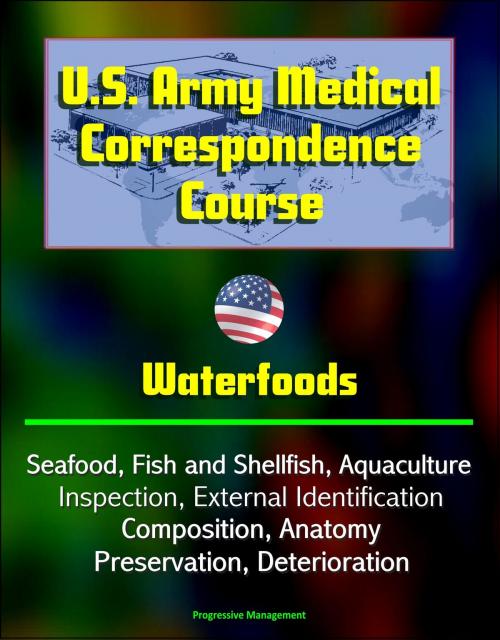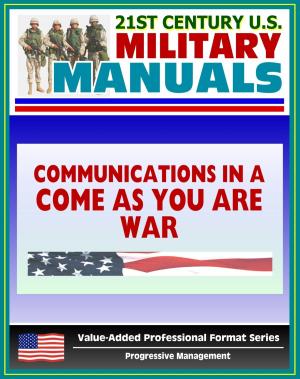U.S. Army Medical Correspondence Course: Waterfoods - Seafood, Fish and Shellfish, Aquaculture, Inspection, External Identification, Composition, Anatomy, Preservation, Deterioration
Nonfiction, Food & Drink, Seafood| Author: | Progressive Management | ISBN: | 9781310366963 |
| Publisher: | Progressive Management | Publication: | October 16, 2014 |
| Imprint: | Smashwords Edition | Language: | English |
| Author: | Progressive Management |
| ISBN: | 9781310366963 |
| Publisher: | Progressive Management |
| Publication: | October 16, 2014 |
| Imprint: | Smashwords Edition |
| Language: | English |
Waterfoods (fish and shellfish) are among the most perishable of all foods and need proper care from the moment they are caught until served or processed. The handling of waterfoods determines to what extent deterioration takes place. This subcourse will deal with the composition, anatomy, market forms, preservation, and deterioration of waterfoods. Destination and surveillance inspection procedures of waterfoods will also be covered, including determining net weight of fish.
The purpose of this subcourse is to provide you with basic (introductory) knowledge concerning waterfoods, which is essential for the veterinary food inspection specialist.
CHAPTER 1 - INSPECTION OF FISH * Section I. Fish: Their Composition, Anatomy, Preparation, and Preservation * Section II. Inspection Procedures for Fish
Exercises / CHAPTER 2 - INSPECTION OF SHELLFISH * Section I. Shellfish: Their Composition, Anatomy, and Deterioration * Section II. Inspection Procedures for Shellfish * Exercises
The term waterfood is applied to the fishery products procured by the Department of Defense (DOD). When applied, it encompasses all varieties of fresh and salt-water finfish and shellfish.
Finfish. Finfish are those species termed endoskeletal (the skeletal structure is contained within its body) containing vertebrae, rib bones, and a skull composed of numerous bones. They are fusiformed (tapering at both ends), roundish, and usually slightly compressed. Some may be greatly compressed (for example, sun perch), or depressed (for example, flounder). Their shape offers little resistance to movement in water.
Shellfish. Shellfish are divided into two groups, mollusk and crustacean. They are referred to as exoskeletal as they have an outer shell covering the body.
Quality. There are many complex chemical changes that occur within waterfood after death. These changes, associated with bacteriological changes, determine the quality. The best quality available is a waterfood that is cooked and consumed immediately after death. To perform an adequate inspection, the veterinary food inspection specialist must be knowledgeable of the chemical composition of waterfood and the chemical and deteriorative changes that may take place.
Waterfoods (fish and shellfish) are among the most perishable of all foods and need proper care from the moment they are caught until served or processed. The handling of waterfoods determines to what extent deterioration takes place. This subcourse will deal with the composition, anatomy, market forms, preservation, and deterioration of waterfoods. Destination and surveillance inspection procedures of waterfoods will also be covered, including determining net weight of fish.
The purpose of this subcourse is to provide you with basic (introductory) knowledge concerning waterfoods, which is essential for the veterinary food inspection specialist.
CHAPTER 1 - INSPECTION OF FISH * Section I. Fish: Their Composition, Anatomy, Preparation, and Preservation * Section II. Inspection Procedures for Fish
Exercises / CHAPTER 2 - INSPECTION OF SHELLFISH * Section I. Shellfish: Their Composition, Anatomy, and Deterioration * Section II. Inspection Procedures for Shellfish * Exercises
The term waterfood is applied to the fishery products procured by the Department of Defense (DOD). When applied, it encompasses all varieties of fresh and salt-water finfish and shellfish.
Finfish. Finfish are those species termed endoskeletal (the skeletal structure is contained within its body) containing vertebrae, rib bones, and a skull composed of numerous bones. They are fusiformed (tapering at both ends), roundish, and usually slightly compressed. Some may be greatly compressed (for example, sun perch), or depressed (for example, flounder). Their shape offers little resistance to movement in water.
Shellfish. Shellfish are divided into two groups, mollusk and crustacean. They are referred to as exoskeletal as they have an outer shell covering the body.
Quality. There are many complex chemical changes that occur within waterfood after death. These changes, associated with bacteriological changes, determine the quality. The best quality available is a waterfood that is cooked and consumed immediately after death. To perform an adequate inspection, the veterinary food inspection specialist must be knowledgeable of the chemical composition of waterfood and the chemical and deteriorative changes that may take place.















